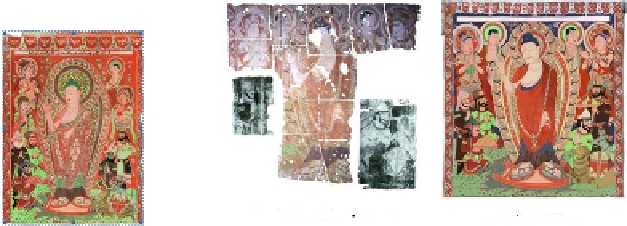Information Technology Reference
In-Depth Information
(a) Cave No. 9 (b) Positional match of wall painting fragments (c) Wall painting restoration result
Fig. 10.
Reconstruction of wall painting
First, we carry out a positional matching for fragments of the wall painting
(Fig.10.(b)) such that a location of characters of drawings for No. 9 cave wall
paintings. (Fig. 10.(a)) Each fragment is in National Museum of India (NewDelhi),
Museum für Indische Kunst (Berlin-Dahlem). Right and left fragments of Museum
für Indische Kunst are not exist, but its drawings are exist.
Next, the lack part of the wall painting is filled using the image database of wall
paints. Fragments are chosen religiously and statistically by shape of hands, shape of
clothes, expression of face and so on. The fragments are done rotation, reduction, and
expansion, and fill the lack space.
Finally, the tone of the entire wall painting is corrected. In this paper the
appearance of the wall painting at the time of be drawn is reproduced. To achieve this,
the spectrum characteristic of the fragment in existence wall painting is measured, it
is necessary to investigate the level of deterioration while comparing it with pigments
previously shown. However, it was difficult to measure the spectrum characteristic of
the fragment of the wall painting. Then the basic color (Blue, white, green, red, flesh-
colored, black, tea, and bitter orange) used by the wall painting based on the analysis
result of pigments previously described was made. The tone is corrected based on
these. Fig.10.(c) shows the result of correcting the tone.
5 3D- Models' Generation of The Cave No. 4
The purpose to generate three dimension model is to present to the user the position of
the wall painting in a buddhist temple intuitively.
There is a method of measuring
actual cave with the range finder for the method of generating three dimension model
of cave. But, by occasion of the above-mentioned, three dimension model is generated
based on the data measured in drawing and several places open to the public without
doing an accurate measurement here. The cave No. 4 is VR reconstructed by doing
the wall painting restored to the generated three dimension model ahead in texture
mapping. Fig.11.(a) shows the appearance of a present cave shrine, Fig.11.(b) shows
the result of VR restoring of the cave shrine.

